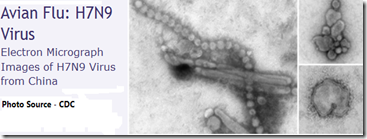[Source: Nature, full page: (LINK). Abstract, edited.]
Nature Communications | Article - <ABBR>Open</ABBR>
<ABBR></ABBR>
<ABBR></ABBR>Influenza A(H7N9) virus gains neuraminidase inhibitor resistance without loss of in vivo virulence or transmissibility
Rong Hai,<SUP>1, 5 </SUP>Mirco Schmolke,<SUP>1, 2, 5 </SUP>Victor H. Leyva-Grado,<SUP>1 </SUP>Rajagowthamee R. Thangavel,<SUP>1 </SUP>Irina Margine,<SUP>1 </SUP>Eric L. Jaffe,<SUP>1 </SUP>Florian Krammer,<SUP>1 </SUP>Alicia Sol?rzano,<SUP>3 </SUP>Adolfo Garc?a-Sastre,<SUP>1, 2, 4 </SUP>Peter Palese<SUP>1, 4 </SUP>& Nicole M. Bouvier<SUP>1, 4</SUP>
<SUP></SUP>
Journal name: Nature Communications / Volume: 4, Article number: 2854 / DOI: doi:10.1038/ncomms3854
Received 23 June 2013 ? Accepted 01 November 2013 - Published 10 December 2013
Abstract
Without baseline human immunity to the emergent avian influenza A(H7N9) virus, neuraminidase inhibitors are vital for controlling viral replication in severe infections. An amino acid change in the viral neuraminidase associated with drug resistance, NA-R292K (N2 numbering), has been found in some H7N9 clinical isolates. Here we assess the impact of the NA-R292K substitution on antiviral sensitivity and viral replication, pathogenicity and transmissibility of H7N9 viruses. Our data indicate that an H7N9 isolate encoding the NA-R292K substitution is highly resistant to oseltamivir and peramivir and partially resistant to zanamivir. Furthermore, H7N9 reassortants with and without the resistance mutation demonstrate comparable viral replication in primary human respiratory cells, virulence in mice and transmissibility in guinea pigs. Thus, in stark contrast to oseltamivir-resistant seasonal influenza A(H3N2) viruses, H7N9 virus replication and pathogenicity in these models are not substantially altered by the acquisition of high-level oseltamivir resistance due to the NA-R292K mutation.
-
------
Nature Communications | Article - <ABBR>Open</ABBR>
<ABBR></ABBR>
<ABBR></ABBR>Influenza A(H7N9) virus gains neuraminidase inhibitor resistance without loss of in vivo virulence or transmissibility
Rong Hai,<SUP>1, 5 </SUP>Mirco Schmolke,<SUP>1, 2, 5 </SUP>Victor H. Leyva-Grado,<SUP>1 </SUP>Rajagowthamee R. Thangavel,<SUP>1 </SUP>Irina Margine,<SUP>1 </SUP>Eric L. Jaffe,<SUP>1 </SUP>Florian Krammer,<SUP>1 </SUP>Alicia Sol?rzano,<SUP>3 </SUP>Adolfo Garc?a-Sastre,<SUP>1, 2, 4 </SUP>Peter Palese<SUP>1, 4 </SUP>& Nicole M. Bouvier<SUP>1, 4</SUP>
<SUP></SUP>
Journal name: Nature Communications / Volume: 4, Article number: 2854 / DOI: doi:10.1038/ncomms3854
Received 23 June 2013 ? Accepted 01 November 2013 - Published 10 December 2013
Abstract
Without baseline human immunity to the emergent avian influenza A(H7N9) virus, neuraminidase inhibitors are vital for controlling viral replication in severe infections. An amino acid change in the viral neuraminidase associated with drug resistance, NA-R292K (N2 numbering), has been found in some H7N9 clinical isolates. Here we assess the impact of the NA-R292K substitution on antiviral sensitivity and viral replication, pathogenicity and transmissibility of H7N9 viruses. Our data indicate that an H7N9 isolate encoding the NA-R292K substitution is highly resistant to oseltamivir and peramivir and partially resistant to zanamivir. Furthermore, H7N9 reassortants with and without the resistance mutation demonstrate comparable viral replication in primary human respiratory cells, virulence in mice and transmissibility in guinea pigs. Thus, in stark contrast to oseltamivir-resistant seasonal influenza A(H3N2) viruses, H7N9 virus replication and pathogenicity in these models are not substantially altered by the acquisition of high-level oseltamivir resistance due to the NA-R292K mutation.
-
------

Comment